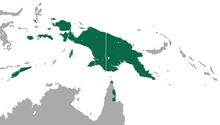| Bare-backed fruit bat | |
|---|---|

| |
| Conservation status | |
 Least Concern (IUCN 3.1) | |
| Scientific classification | |
| Domain: | Eukaryota |
| Kingdom: | Animalia |
| Phylum: | Chordata |
| Class: | Mammalia |
| Order: | Chiroptera |
| Family: | Pteropodidae |
| Genus: | Dobsonia |
| Species: | D. moluccensis |
| Binomial name | |
| Dobsonia moluccensis (Quoy & Gaimard, 1830) | |

| |
| Bare-backed fruit bat range | |
| Synonyms | |
| |

The bare-backed fruit bat or Moluccan naked-backed fruit bat (Dobsonia moluccensis) is a fruit bat in the family Pteropodidae.
Taxonomy and etymology
It was described as a new species in 1830 by Jean René Constant Quoy and Joseph Paul Gaimard who placed it in the now-defunct bat genus Hypoderma, with the scientific name H. moluccensis. Its relationship with Dobsonia magna requires further investigation. Its species name "moluccensis" means "belonging to the Moluccas," which is where the species is found.
Description
Its fur is brown and its feet have distinctive white claws. It is smaller than the New Guinea naked-backed fruit bat. Males weigh 380–500 g (0.84–1.10 lb) while females weigh 325–525 g (0.717–1.157 lb). Its ears are pointed, and its second digits lack claws, unlike flying foxes. Its wings attach at the back along the spine rather than along the sides of the body.
Biology and ecology
The bare-backed fruit bat is a seasonal breeder, with the mating season from April to June. Females give birth from mid-August through November. It is found in Indonesia, East Timor, Papua New Guinea, and Australia. It has been documented from 0–2,700 m (0–8,858 ft) above sea level.
As of 2016, it is considered a least-concern species by the IUCN.
References
- ^ Tsang, S.M. (2016). "Dobsonia moluccensis". IUCN Red List of Threatened Species. 2016: e.T84882605A22033630. doi:10.2305/IUCN.UK.2016-3.RLTS.T84882605A22033630.en. Retrieved 19 November 2021.
- Quoy, J.R.; Gaimard, J.P. (1830). Voyage de la corvette l'Astrolabe : exécuté par ordre du roi, pendant les années 1826-1827-1828-1829. Vol. 1. Paris :J. Tastu, 1830-1834. pp. 86–88.
- Flannery, T. (1995). Mammals of the South-West Pacific & Moluccan Islands. Cornell University Press. p. 202. ISBN 978-0801431500.
- ^ Nowak, R. M. (1994). Walker's Bats of the World. JHU Press. pp. 61–62. ISBN 978-0801849862.
| Taxon identifiers | |
|---|---|
| Dobsonia moluccensis | |